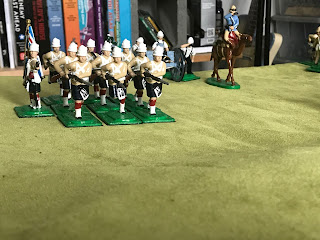I had another go at Crossfire this weekend. This time, I fielded a scenario that gave me fits when played with my own rules - The River. It works much better using Crossfire! As a note, my table is 3x3, because the bases are 2" x 2", which is slightly larger than standard.
Pictured below is the second game - the first wasn't supposed to happen, I was just setting up the table late Saturday night, in advance of Sunday's game, and thought, "Well, maybe I'll just move some stands around for fun." Before you knew it, I had played an entire game.
The Germans got off to a poor start - no smoke landed and their recon by fire failed.
So the Soviets popped up with their MG and started firing. Fortunately for the Germans they were mostly ineffective.
After several short initiatives of failed smoke arrival, the Germans managed to land some which allowed the river crossing to begin. That brought the Soviets in the bunker into the action.
The German engineers walked right into the minefield and started clearing it. Fortunately the Soviets in the bunker were incompetent.
 |
| I didn't feel like getting out the cotton batting to set up the smoke so I used these "markers" I created years ago. I think they fit the look of my table. |
With the mines cleared, and with some help from their 50mm mortar
landing smoke,the Germans were waded their infantry into the river.
The Soviet mortars gave the attackers some trouble when the smoke cleared
But using the woods as cover, the Germans were able to storm the building. Fierce close combat followed. In the end, the defenders were wiped out to a man: heroes of the Motherland, all.
 |
| I used the Bogged Down markers to indicate "no fire". |
The Soviet FOO and mortar turned their attention to bombarding the formerly-held building.
While the Germans launched an attack on the bunker, supported by their mortars.
Having cleared that obstacle, they moved on to capture the Soviet FOO and wipe out the Soviet mortar in close combat.
End of the game,the Germans held the objective and the Soviets were completely eliminated.
As a solo game, Crossfire, like most games, works well- although the hidden units in these scenarios takes a little effort to setup in a satisfying way. I think the hardest part about solo play with Crossfire is the need to always be aware of when the inactive side has an opportunity for reactive fire. Unlike some games, where a missed opportunity for reactive fire isn't the end of the world, in Crossfire it's the difference between stealing the initiative and not getting a chance to be the active side.
The solo player is forced to dedicate some brain power to examining every action from the perspective of both sides. It's not insurmountable, and I find the mental involvement enjoyable, but I can imagine some solo players would find it less so.





























































